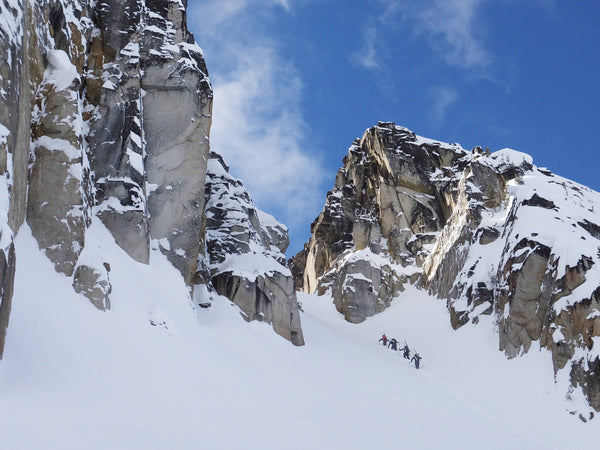FACETS & Decision Making in Avalanche Terrain By: Joe Schwartz
Read Blog (Part II) Decision Making: THE SYSTEM
Every fall season, the temperatures drop and snow starts to coat the home ranges. We dust off our ski gear and prepare for the winter ahead. An annual event for backcountry shredders should be getting together with friends and refreshing avalanche rescue skills: transceiver searching, probing, shoveling and first aid. These hard skills are obviously critical to keep sharp, but what about our equally as important decision making skills?
When was the last time you sat down and worked on your decision making process with your touring buddies? Our rescue skills are important, but why aren’t we paying an equal amount of attention to the skills that keep us out of those life-or-death rescue situations in the first place?

Practice skills in the fall to have your ducks in a row before winter comes.
Playing Follow the Leader at Whitecap.
This series of articles will touch on different aspects of decision making, and will hopefully reinforce the importance of engaging in critical thinking and using step-by-step decision making processes in order to avoid getting into situations in which you have to pull out your rescue gear at all!

Which heuristic trap led to this poor decision? Aspen, Colorado, January 2021. Photo: Whitton Feer
FACETS
Humans are all wired the same. Our brains develop in a way that favours shortcuts. If we had to analyze every day-to-day situation fully, we’d never get anything done. Things like brushing our teeth, driving, greeting people: We use a “rule of thumb” approach when we are confronted by decision processes like this. These “rules” are called heuristics. Without these we’d be useless anxious messes before breakfast.
The issue with heuristics is that we can find ourselves utilizing these “rules of thumb” in more risky environments, like in avalanche terrain. If anyone has ever found themselves saying “well, it must be good to go if they skied it” or “I’ve skied this line a million times, and it never slides”, you’ve fallen into the heuristic trap.

A handy acronym, FACETS, has been developed to help remember, identify, and avoid these heuristic traps. I’ll reference FACETS before a day out, during the day, and will also use it in my end-of-day debriefs to determine if we made good decisions out there, or if we just got lucky.
F - Familiarity
“I’ve been here a bunch before, I feel really comfortable with this..” Familiarity breeds complacency, and that can get you killed in avalanche terrain. Familiar terrain does not equal safer, and should not change the way you approach a ski line.
A - Acceptance
We have an innate desire to fit in with a social group. This need to be accepted can lead to making more aggressive decisions, or willful ignorance of clear signs of elevated hazard. This heuristic trap pops up most often in mixed-gender groups. Another case of dudes trying to impress the ladies.
C -Consistency/Commitment
“Summit or plummet!!” This decision-making trap is as easy to fall into as it is to avoid. With no backup plan (or plans) we get the blinders on, and find reasons to continue on, until it’s too late. Always go out with a Plan A, and Plan B, and Plan C (and more if required), and this heuristic trap can be avoided.
E - Expert Halo
It’s easy to defer all decision making to the “expert” in the group, when they are assumed to know everything. This could be the person with the most years of experience, the best skier in the group, or an actual guide. The best way to avoid this trap? Talk it out. Even in a guided group, everyone’s experience and perspective is valid and important.
T - Tracks (or scarcity of)
Ever heard “if we don’t ski it, someone else will”, “there’s already tracks, it’s good to go”, or “we have to hustle before that other group poaches us!”. These are heuristic trap red flags. Once we get the “powder fever” it’s hard to make rational decision that aren’t affected by our insatiable need to shred blower pow.
S - Social Facilitation
Why is that when we’re skiing under a lift, knowing that we’ve got an audience, we shred harder? That’s because we all have something to prove. This heuristic trap rears its ugly head when people are watching. We make more aggressive decisions when we perceive we are being watched (ie another group in the same zone as us).
This early season, dust off and practice with your transceiver, probe and shovel. But when you do, sit down with your touring buddies and review your decision making process as well. How do you currently approach decision making in avalanche terrain? How can you improve? Having a dialed system will make your days out this season that much safer, and more fun for all involved.

Happy clients after a heli drop in the Pemberton backcountry. The best ski clients are the ones I can make decisions WITH, and not FOR.
